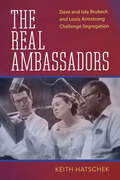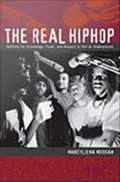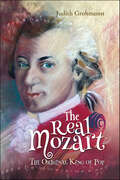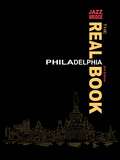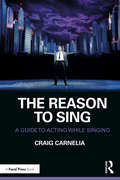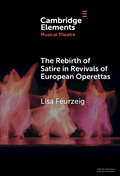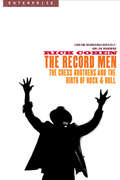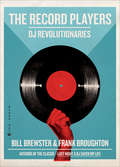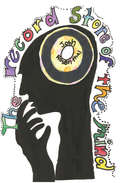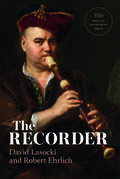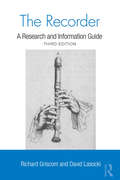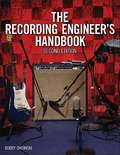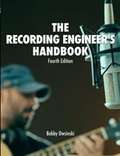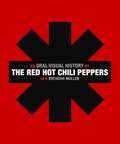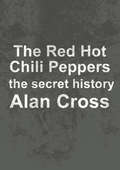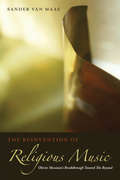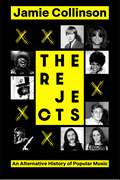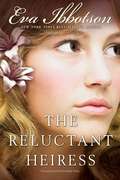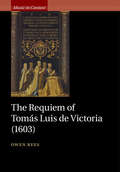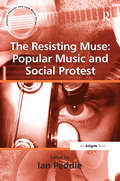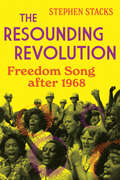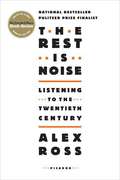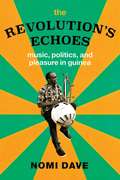- Table View
- List View
The Real Ambassadors: Dave and Iola Brubeck and Louis Armstrong Challenge Segregation (American Made Music Series)
by Keith HatschekWinner of the 2023 ASCAP Foundation Deems Taylor/Virgil Thomson Book AwardRecipient of a 2023 Certificate of Merit for Best Historical Research in Recorded Jazz from the Association for Recorded Sound CollectionsKeith Hatschek tells the story of three determined artists: Louis Armstrong, Dave Brubeck, and Iola Brubeck and the stand they took against segregation by writing and performing a jazz musical titled The Real Ambassadors. First conceived by the Brubecks in 1956, the musical’s journey to the stage for its 1962 premiere tracks extraordinary twists and turns across the backdrop of the civil rights movement. A variety of colorful characters, from Broadway impresarios to gang-connected managers, surface in the compelling storyline. During the Cold War, the US State Department enlisted some of America’s greatest musicians to serve as jazz ambassadors, touring the world to trumpet a so-called “free society.” Honored as celebrities abroad, the jazz ambassadors, who were overwhelmingly African Americans, returned home to racial discrimination and deferred dreams. The Brubecks used this double standard as the central message for the musical, deploying humor and pathos to share perspectives on American values. On September 23, 1962, The Real Ambassadors’s stunning debut moved a packed arena at the Monterey Jazz Festival to laughter, joy, and tears. Although critics unanimously hailed the performance, it sadly became a footnote in cast members’ bios. The enormous cost of reassembling the star-studded cast made the creation impossible to stage and tour. However, The Real Ambassadors: Dave and Iola Brubeck and Louis Armstrong Challenge Segregation caps this jazz story by detailing how the show was triumphantly revived in 2013 by the Detroit Jazz Festival and in 2014 by Jazz at Lincoln Center. This reaffirmed the musical’s place as an integral part of America’s jazz history and served as an important reminder of how artists’ voices are a powerful force for social change.
The Real Hiphop: Battling for Knowledge, Power, and Respect in the LA Underground
by Marcyliena MorganProject Blowed is a legendary hiphop workshop based in Los Angeles. It began in 1994 when a group of youths moved their already renowned open-mic nights from the Good Life, a Crenshaw district health food store, to the KAOS Network, an arts center in Leimert Park. The local freestyle of articulate, rapid-fire, extemporaneous delivery, the juxtaposition of meaningful words and sounds, and the way that MCs followed one another without missing a beat, quickly became known throughout the LA underground. Leimert Park has long been a center of African American culture and arts in Los Angeles, and Project Blowed inspired youth throughout the city to consider the neighborhood the epicenter of their own cultural movement. The Real Hiphop is an in-depth account of the language and culture of Project Blowed, based on the seven years Marcyliena Morgan spent observing the workshop and the KAOS Network. Morgan is a leading scholar of hiphop, and throughout the volume her ethnographic analysis of the LA underground opens up into a broader examination of the artistic and cultural value of hiphop. Morgan intersperses her observations with excerpts from interviews and transcripts of freestyle lyrics. Providing a thorough linguistic interpretation of the music, she teases out the cultural antecedents and ideologies embedded in the language, emphases, and wordplay. She discusses the artistic skills and cultural knowledge MCs must acquire to rock the mic, the socialization of hiphop culture's core and long-term members, and the persistent focus on skills, competition, and evaluation. She brings attention to adults who provided material and moral support to sustain underground hiphop, identifies the ways that women choose to participate in Project Blowed, and vividly renders the dynamics of the workshop's famous lyrical battles.
The Real Mozart: The Original King of Pop
by Judith GrohmannBorn in Salzburg in 1756, Wolfgang Amadeus Mozart was one of the most prolific musicians that ever lived. Here, the author Judith Grohmann takes us behind the curtain of the career to reveal the real personality of the composer, whose influence on the world of music is still profound today. A child prodigy, he played several instruments from a tender age and eventually created his own style by blending the traditional with the contemporary. He was beloved and hyped, but was also a multi-layered and controversial personality: on one side a provocative influencer, hyperactive and a driven man, a bon vivant who loved luxury, but on the other side, a man who was drawn to the Masonic mindset of brotherhood, freedom, tolerance and humanity, with frequent and extreme mood changes and a penchant for word games and a peculiar sense of humor. In his short life, Mozart anticipated almost everything that makes a star today: international tours, hysterical fans, success, big hits, sex and addiction. He wrote obsessively and composed more than 600 different operas, sonatas, masses, concerts and symphonies. As far as we know today, Mozart's oeuvre contains around 1,060 titles. Knighted by the Pope aged just 14 (the greatest award for any artist at the time), today he might have been showered with Grammys and platinum discs in recognition of his status as the original 'King of Pop'.
The Real Philadelphia Book
by Jazz BridgeThe Real Philadelphia Book, compiled by Jazz Bridge and editors David Dzubinski and Suzanne Cloud, is a collection of more than 200 original jazz and blues compositions. Arranged alphabetically by song title, the sheet music showcases work by generations of Philadelphia musicians. This volume, which is “what every aspiring jazz musician needs to know,” features tunes from Grammy Award-winners Jimmy Heath, Grover Washington, Jr., and Christian McBride, as well as legends such as Joey DeFrancesco, Ray Bryant, and Robin and Duane Eubanks. Also included are rare compositions by jazz greats Bobby Timmons, Hank Mobley, and Lee Morgan, in addition to music by local luminaries, Rhenda Fearrington, Monnette Sudler, and Kaylé Brecher. The aim of The Real Philadelphia Book is to help the jazz community make deeper, stronger connections while also formally documenting much of the important music created in the Philadelphia metro area by both well- and lesser-known musicians. Including an index of composers, The Real Philadelphia Bookwill enhance and add to the rich Philadelphia jazz and blues tradition and make the Philly jazz catalogue more easily available to musicians, jazz students and educators around the world.
The Reason to Sing: A Guide to Acting While Singing
by Craig CarneliaIn The Reason to Sing, renowned composer-lyricist and teacher Craig Carnelia provides musical actors with a step-by-step guide to making their singing performances more truthful, vivid, and full of life. Using a technique developed over decades of teaching the professional community of Broadway actors and students alike, The Reason to Sing utilizes detailed descriptions of sessions the author has had with his notable students and lays out a new and proven approach to help you build your skills, your confidence, and your career. This book is intended for musical theater acting students as well as working professionals and teachers of the craft.
The Rebirth of Satire in Revivals of European Operettas (Elements in Musical Theatre)
by Lisa FeurzeigSince 1997, revivals have moved operetta away from the nostalgic performance style of the mid twentieth century, returning to its original satirical spirit grounded in ironic mockery of political and social norms and institutions. This Element compares productions of Offenbach's Belle Hélène and Kálmán's Herzogin von Chicago, considering their choices with regard to plot, text, performance style, music, and costumes and sets. In every case, there is some reinterpretation involved. Satire of times, places, and current politics can be found. Some versions tweak the original while others expand and alter it in a full Regietheater approach, often influenced by a postmodern aesthetic. Directors and performers perceive an opportunity to recreate the central experience of operetta – but is that defined as the original text, Dionysian pleasure, or absurdist theater? The genre lives on mostly through creative approaches to revival.
The Record Men: The Chess Brothers and the Birth of Rock & Roll (Enterprise)
by Rich Cohen"Brilliant; the best book I have ever read about the recording industry; a classic."--Larry King On the south side of Chicago in the late 1940s, two immigrants; one a Jew born in Russia, the other a black blues singer from Mississippi; met and changed the course of musical history. Muddy Waters electrified the blues, and Leonard Chess recorded it. Soon Bo Diddly and Chuck Berry added a dose of pulsating rhythm, and Chess Records captured that, too. Rock & roll had arrived, and an industry was born. In a book as vibrantly and exuberantly written as the music and people it portrays, Rich Cohen tells the engrossing story of how Leonard Chess, with the other record men, made this new sound into a multi-billion-dollar business; aggressively acquiring artists, hard-selling distributors, riding the crest of a wave that would crash over a whole generation. Originally published in hardcover as Machers and Rockers. About the series: Enterprise pairs distinguished writers with stories of the economic forces that have shaped the modern worlds; the institutions, the entrepreneurs, the ideas. Enterprise introduces a new genre; the business book as literature.
The Record Players: DJ Revolutionaries
by Bill Brewster Frank BroughtonFrom the co-authors of the classic Last Night a DJ Saved My Life: A fascinating oral history of record spinning told by the groundbreaking DJs themselves. Acclaimed authors and music historians Bill Brewster and Frank Broughton have spent years traveling across the world to interview the revolutionary and outrageous DJs who shaped the last half-century of pop music. The Record Players is the fun and revealing result—a collection of firsthand accounts from the obsessives, the playboys, and the eccentrics that dominated the music scene and contributed to the evolution of DJ culture. In the sixties, radio tastemakers brought their sound to the masses, while early trendsetters birthed the role of the club DJ at temples of hip like the Peppermint Lounge. By the seventies, DJs were changing the course of popular music; and in the eighties, young innovators wore out their cross-faders developing techniques that turned their craft into its own form of music. With discographies, favorite songs, and amazing photos of all the DJs as young firebrands, The Record Players offers an unparalleled music education: from records to synthesizers, from disco to techno, and from influential cliques to arenas packed with thousands of dancing fans.
The Record Store of the Mind
by Josh RosenthalIn your hands "the Keys To The Kingdom" ... a ceaseless whirligig of histories, opinion and romance ... of characters and circumstance minor and major contributors to our great wonderland ... music beloved music ... I reveled within and learned much ... a unique work -- Robert Plant"Josh Rosenthal is a record man's record man. He is also a musician's record man. He is in the line of Samuel Charters and Harry Smith. In this age where we have access to everything and know the value of nothing, musicians need people like Josh to hear them when no one else can." T Bone BurnettGrammy-nominated producer and Tompkins Square label founder Josh Rosenthal presents his first book, The Record Store of the Mind. Part memoir, part "music criticism", the author ruminates over unsung musical heroes, reflects on thirty years of toil and fandom in the music business, and shamelessly lists some of the LPs in his record collection. Crackling with insightful untold stories, The Record Store of the Mind will surely delight and inspire passionate music lovers ... especially those who have spent way too many hours in record stores.Celebrating ten years in 2015, Rosenthal's San Francisco-based independent record label Tompkins Square has received seven Grammy nominations and wide acclaim for its diverse catalog of new and archival recordings.
The Recorder: A Research And Information Guide (Yale Musical Instrument Series)
by Robert Ehrlich David Lasocki Nikolaj TarasovThe fascinating story of a hugely popular instrument, detailing its rich and varied history from the Middle Ages to the present The recorder is perhaps best known today for its educational role. Although it is frequently regarded as a stepping-stone on the path toward higher musical pursuits, this role is just one recent facet of the recorder’s fascinating history—which spans professional and amateur music-making since the Middle Ages. In this new addition to the Yale Musical Instrument Series, David Lasocki and Robert Ehrlich trace the evolution of the recorder. Emerging from a variety of flutes played by fourteenth-century soldiers, shepherds, and watchmen, the recorder swiftly became an artistic instrument for courtly and city minstrels. Featured in music by the greatest Baroque composers, including Bach and Handel, in the twentieth century it played a vital role in the Early Music Revival and achieved international popularity and notoriety in mass education. Overall, Lasocki and Ehrlich make a case for the recorder being surprisingly present, and significant, throughout Western music history.
The Recorder: A Research and Information Guide (Routledge Music Bibliographies #Vol. 2)
by Richard W. Griscom David LasockiA Choice "Best Academic" book in its first edition, The Recorder remains an essential resource for anyone who wants to know about this instrument. This new edition is thoroughly redone, takes account of the publishing activity of the years since its first publication, and still follows the original organization.
The Recording Engineer's Handbook (2nd edition)
by Bobby OwsinskiWorking as a recording engineer presents challenges from every direction of your project. From using microphones to deciding on EQ settings, choosing outboard gear to understanding how, when and why to process your signal, the seemingly never-ending choices can be very confusing. Professional Audio's bestselling author Bobby Owsinski (The Mixing Engineer's Handbook, The Mastering Engineer's Handbook) takes you into the tracking process for all manner of instruments and vocals-- providing you with the knowledge and skill to make sense of the many choices you have in any given project. From acoustic to electronic instruments, mic placement to EQ settings, everything you need to know to capture professionally recorded audio tracks is in this guide.
The Recording Engineers Handbook
by Bobby OwsinskiBobby Owsinski's The Recording Engineer's Handbook has become a music industry standard, and this fully updated fourth edition once again offers the most comprehensive and up-to-date introduction to the art of audio recording. Written with special emphasis on today's technology and the evolving marketplace, The Recording Engineer's Handbook Fourth Edition includes a complete overview of recording as it's done by most musicians and producers today in their home studios. In the book's first section, you'll learn everything from how microphones work to specific techniques for recording drums, individual instruments, vocals and much more. In the second section you'll benefit from the wisdom and down-to-earth practical advice offered by a host recording professionals including all-time greats like Al Schmitt, Eddie Kramer, Frank Filipetti and many other others. <P><P>Topics covered include: An overview of recording elements, including microphones, preamps, compressors and DAWs, Recording techniques and placement guidance for just about any musical instrument or vocal, Prepping and recording drums and percussion, Basic tracking and overdub advice and strategies, and stereo and immersive audio recording techniques, Interviews with some of the world's best hit-making engineers, and much more. <P><P>Learn the art of recording with renowned author, teacher, producer and engineer Bobby Owsinski, and, in the interviews, explore the creative processes behind not only today's hits but the classic cuts we've enjoyed for years. See for yourself why The Recording Engineer’s Handbook, Fourth Edition is the book that's a standard text in college courses all over the world.
The Red Hot Chili Peppers: An Oral/Visual History
by The ChiliThe Red Hot Chili Peppers is the iconic band's audacious look back at their thirty-year odyssey—in their own words and accompanied by more than 300 spectacular photos and ephemera. Intimate, breathtaking, and outrageous, this is the essence of the Red Hot Chili Peppers."I am struck with the moments of these photos, the feelings of the times they were taken, and where we were at on our beautiful and happy-sad journey. It's pretty fucking heavy, actually, like thinking how much we have changed over the years, and all the different dynamics of our lives that shaped us, and also realizing so clearly that nothing has changed at all—we're all still just trying to get it on, make something great."It is all here, nothing can hide: all the honesty, the pretense, the courage and one-of-a-kind-ness, the unbridled joy, the melancholy, and the shields we put up to shelter our scared, vulnerable little selves."—Flea
The Red Hot Chili Peppers: The Secret History (The\secret History Of Rock Ser.)
by Alan CrossAlan Cross is the preeminent chronicler of popular music.Here he looks at the Red Hot Chili Peppers from their founding through 2008.This snapshot of "the right band with the right sound at the right time" is adapted from the audiobook.
The Regulation and Reform of Music Criticism in Nineteenth-Century England (Royal Musical Association Monographs)
by Paul WattMusic criticism in England underwent profound change from the 1880s to the 1920s. It gave rise to ‘New criticism’ that aimed to be rational, impartial and intellectually authoritative. It was a break from the criticism of old: the work of the opinionated journalist who wrote descriptive concert reviews with invective, cliché, bias and bombast. Critics such as Ernest Newman (1868–1959), John F. Runciman (1866–1916) and Michel D. Calvocoressi (1877–1944) fostered this new school and wrote extensively of their aspirations for musical criticism in their own times and for the future. This book charts the genesis of this new wave of musical criticism that sought to regulate and reform the profession of music critic. Alongside the establishment of principles, training manuals and schools for critics, hundreds of journal articles and dozens of books were written that encouraged new criticism, which also had a bearing on scholarly writing in biography, aesthetics and history. The Regulation and Reform of Music Criticism in Nineteenth-Century England considers the influence and advocacy of individual critics and the role that institutions, such as the Musical Association and the Musical Times, played in this period of change. The book also explores the impact that French and German writers had on their English counterparts, demonstrating the internationalization of critical thought of the period.
The Reinvention of Religious Music: Olivier Messiaen's Breakthrough Toward the Beyond
by Sander van MaasOn the basis of a careful analysis of Olivier Messiaen's work, this book argues for a renewal of our thinking about religious music. Addressing his notion of a "hyper-religious" music of sounds and colors, it aims to show that Messiaen has broken new ground. His reinvention of religious music makes us again aware of the fact that religious music, if taken in its proper radical sense, belongs to the foremost of musical adventures.The work of Olivier Messiaen is well known for its inclusion of religious themes and gestures. These alone, however, do not seem enough to account for the religious status of the work. Arguing for a "breakthrough toward the beyond" on the basis of the synaesthetic experience of music, Messiaen invites a confrontation with contemporary theologians and post-secular thinkers. How to account for a religious breakthrough that is produced by a work of art?Starting from an analysis of his 1960s oratorio La Transfiguration de Notre-Seigneur Jésus-Christ, this book arranges a moderated dialogue between Messiaen and the music theology of Hans Urs von Balthasar, the phenomenology of revelation of Jean-Luc Marion, the rethinking of religion and technics in Jacques Derrida and Bernard Stiegler, and the Augustinian ruminations of Søren Kierkegaard and Jean-François Lyotard. Ultimately, this confrontation underscores the challenging yet deeply affirmative nature of Messiaen's music.
The Rejects: An Alternative History of Popular Music
by Jamie CollinsonImagine you've made it. You and your friends have hit the big time in music and you're going to be a star. But then, quite suddenly, it's over. Your best friends don't want you anymore, and you're on the outside. Perhaps they're tired of your bad habits, they think you're not good enough, or they sense you just don't want it as much as they do. Whatever the cause, you're a reject. So, what do you do next?Featuring a player rejected by both Nirvana and Soundgarden who became a decorated special forces soldier, Britpoppers who spiralled into addiction before becoming novelists and missionaries, the terrifying story of Guns N' Roses' first drummer, super-rejecting band leaders, self-destroying rappers, troubled hard rock bassists and girl-band burnouts, The Rejects takes an intimate, thoughtful look at people who've been kicked out of bands, what they experienced and what came afterwards.Coming from a writer with twenty years' music industry experience, The Rejects is a sympathetic study of some of music's most fascinating characters, and what happens when the dream comes crashing to an end. The result is a compelling alternative history of popular music.
The Rejects: An Alternative History of Popular Music
by Jamie CollinsonImagine you've made it. You and your friends have hit the big time in music and you're going to be a star. But then, quite suddenly, it's over. Your best friends don't want you anymore, and you're on the outside. Perhaps they're tired of your bad habits, they think you're not good enough, or they sense you just don't want it as much as they do. Whatever the cause, you're a reject. So, what do you do next?Featuring a player rejected by both Nirvana and Soundgarden who became a decorated special forces soldier, Britpoppers who spiralled into addiction before becoming novelists and missionaries, the terrifying story of Guns N' Roses' first drummer, super-rejecting band leaders, self-destroying rappers, troubled hard rock bassists and girl-band burnouts, The Rejects takes an intimate, thoughtful look at people who've been kicked out of bands, what they experienced and what came afterwards.Coming from a writer with twenty years' music industry experience, The Rejects is a sympathetic study of some of music's most fascinating characters, and what happens when the dream comes crashing to an end. The result is a compelling alternative history of popular music.
The Reluctant Heiress
by Eva IbbotsonIn 1920s Austria, no one in the Viennese opera company knows that their wardrobe mistress Tessa is really a princess. But when the dashing self-made millionaire Guy Farne arrives at the opera, Tessa realizes that there may be more to life -- and love -- than just music.
The Requiem of Tomás Luis de Victoria (Music in Context)
by Owen ReesVictoria's Requiem is among the best-loved and most-performed musical works of the Renaissance, and is often held to be 'a Requiem for an age', representing the summation of golden-age Spanish polyphony. Yet it has been the focus of surprisingly little research. Owen Rees's multifaceted study brings together the historical and ritual contexts for the work's genesis, the first detailed musical analysis of the Requiem itself, and the long story of its circulation and reception. Victoria composed this music in 1603 for the exequies of María of Austria, and oversaw its publication two years later. A rich variety of contemporary documentation allows these events - and the nature of music in Habsburg exequies - to be reconstructed vividly. Rees then locates Victoria's music within the context of a vast international repertory of Requiems, much of it previously unstudied, and identifies the techniques which render this work so powerfully distinctive and coherent.
The Resisting Muse: Popular Music and Social Protest (Ashgate Popular and Folk Music Series)
by Ian PeddiePopular music has traditionally served as a rallying point for voices of opposition, across a huge variety of genres. This volume examines the various ways popular music has been deployed as anti-establishment and how such opposition both influences and responds to the music produced. Implicit in the notion of resistance is a broad adversarial hegemony against which opposition is measured. But it would be wrong to regard the music of popular protest as a kind of dialogue in league against 'the establishment'. Convenient though they are, such 'us and them' arguments bespeak a rather shop-worn stance redolent of youthful rebellion. It is much more fruitful to perceive the relationship as a complex dialectic where musical protest is as fluid as the audiences to which it appeals and the hegemonic structures it opposes. The book's contemporary focus (largely post-1975) allows for comprehensive coverage of extremely diverse forms of popular music in relation to the creation of communities of protest. Because such communities are fragmented and diverse, the shared experience and identity popular music purports is dependent upon an audience collectivity that is now difficult to presume. In this respect, The Resisting Muse examines how the forms and aims of social protest music are contingent upon the audience's ability to invest the music with the 'appropriate' political meaning. Amongst a plethora of artists, genres, and themes, highlights include discussions of Aboriginal rights and music, Bauhaus, Black Sabbath, Billy Bragg, Bono, Cassette culture, The Capitol Steps, Class, The Cure , DJ Spooky, Drum and Bass, Eminem, Farm Aid, Foxy Brown, Folk, Goldie, Gothicism, Woody Guthrie, Heavy Metal, Hip-hop, Independent/home publishing, Iron Maiden, Joy Division, Jungle, Led Zeppelin, Lil'Kim, Live Aid, Marilyn Manson, Bob Marley, MC Eiht, Minor Threat, Motown, Queen Latifah, Race, Rap, Rastafarianism, Reggae, The Roots, Diana Ross, Rush, Salt-n-Pepa, 7 Seconds, Roxanne Shanté, Siouxsie and the Banshees, The Sisters of Mercy, Michelle Shocked, Bessie Smith, Straight edge Sunrize Band, Bunny Wailer, Wilco, Bart Willoughby, Wirrinyga Band, Zines.
The Resounding Revolution: Freedom Song after 1968 (Music in American Life)
by Stephen StacksFar from being bounded by the timeframe of the 1960s, freedom song continues to evolve as a tool both of historical memory and of present activism. Stephen Stacks looks at how post-1968 freedom song helps us negotiate our present relationship to the era while at the same time sustaining the contemporary struggle inspired by it. Stacks’s analysis shifts the focus of attention from genre--freedom song--to process and practice--freedom singing. As he shows, freedom singing after 1968 generates multilayered meanings. It can reinforce, or resist, consensus memories or dominant narratives. Stacks illuminates freedom singing’s diversity by examining it in three contexts: performance, protest, and within documentary sound recording/film. Insightful and vividly detailed, The Resounding Revolution examines sixty years of Black music to challenge and reshape the entrenched story of the Civil Rights Movement.
The Rest Is Noise: Listening to the Twentieth Century
by Alexander RossRoss (music critic for The New Yorker) tells the story of 20th century classical composition, which for him is an "untamed art, and unassimilated underground." While composers from Richard Strauss to John Adams lie at the heart of the narrative, Ross also places them within a social and political world, describing the politicians, dictators, corporate officers, art patrons, intellectuals, and critics who have attempted to adjudicate and control musical expression and the social upheavals that impacted the lives of composers and the music they produced. He also goes beyond the genre confines of classical to discuss connections to such artists as Duke Ellington, Miles Davis, the Beatles, and the Velvet Underground.
The Revolution’s Echoes: Music, Politics, and Pleasure in Guinea (Chicago Studies in Ethnomusicology)
by Nomi DaveMusic has long been an avenue for protest, seen as a way to promote freedom and equality, instill hope, and fight for change. Popular music, in particular, is considered to be an effective form of subversion and resistance under oppressive circumstances. But, as Nomi Dave shows us in The Revolution’s Echoes, the opposite is also true: music can often support, rather than challenge, the powers that be. Dave introduces readers to the music supporting the authoritarian regime of former Guinean president Sékou Touré, and the musicians who, even long after his death, have continued to praise dictators and avoid dissent. Dave shows that this isn’t just the result of state manipulation; even in the absence of coercion, musicians and their audiences take real pleasure in musical praise of leaders. Time and again, whether in traditional music or in newer genres such as rap, Guinean musicians have celebrated state power and authority. With The Revolution’s Echoes, Dave insists that we must grapple with the uncomfortable truth that some forms of music choose to support authoritarianism, generating new pleasures and new politics in the process.
